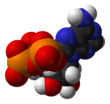
Back Adenosientrifosfaat Afrikaans أدينوسين ثلاثي الفوسفات Arabic Adenozintrifosfat turşusu Azerbaijani آدنوزین تریفوسفات AZB Аденозинтрифосфор кислотаһы — АТФ Bashkir Адэназінтрыфосфарная кіслата Byelorussian Аденозинтрифосфат Bulgarian অ্যাডিনোসিন ট্রাইফসফেট Bengali/Bangla ཨེ་ཊི་པི་འདུས་རྡུལ། Tibetan Adenozin-trifosfat BS

| |||
| |||
| Names | |||
|---|---|---|---|
| IUPAC name
Adenosine 5′-(tetrahydrogen triphosphate)
| |||
| Systematic IUPAC name
O1-{[(2R,3S,4R,5R)-5-(6-Amino-9H-purin-9-yl)-3,4-dihydroxyoxolan-2-yl]methyl} tetrahydrogen triphosphate | |||
| Identifiers | |||
| |||
3D model (JSmol)
|
|||
| ChEBI | |||
| ChEMBL | |||
| ChemSpider | |||
| DrugBank | |||
| ECHA InfoCard | 100.000.258 | ||
| KEGG | |||
PubChem CID
|
|||
| UNII | |||
CompTox Dashboard (EPA)
|
|||
| |||
| |||
| Properties | |||
| C10H16N5O13P3 | |||
| Molar mass | 507.18 g/mol | ||
| Density | 1.04 g/cm3 (disodium salt) | ||
| Melting point | 187 °C (369 °F; 460 K) disodium salt; decomposes | ||
| Acidity (pKa) | 0.9, 1.4, 3.8, 6.5 | ||
| UV-vis (λmax) | 259 nm[1] | ||
| Absorbance | ε259 = 15.4 mM−1 cm−1 [1] | ||
Except where otherwise noted, data are given for materials in their standard state (at 25 °C [77 °F], 100 kPa).
| |||

Adenosine triphosphate (ATP) is a nucleoside triphosphate[2] that provides energy to drive and support many processes in living cells, such as muscle contraction, nerve impulse propagation, and chemical synthesis. Found in all known forms of life, it is often referred to as the "molecular unit of currency" for intracellular energy transfer.[3]
When consumed in a metabolic process, ATP converts either to adenosine diphosphate (ADP) or to adenosine monophosphate (AMP). Other processes regenerate ATP. It is also a precursor to DNA and RNA, and is used as a coenzyme. An average adult human processes around 50 kilograms (about 100 moles) daily.[4]
From the perspective of biochemistry, ATP is classified as a nucleoside triphosphate, which indicates that it consists of three components: a nitrogenous base (adenine), the sugar ribose, and the triphosphate.
- ^ a b "Adenosine 5'-triphosphate disodium salt Product Information" (PDF). Sigma. Archived (PDF) from the original on 2019-03-23. Retrieved 2019-03-22.
- ^ Dunn, Jacob; Grider, Michael H. (2023). "Physiology, Adenosine Triphosphate". StatPearls. StatPearls Publishing. PMID 31985968. Retrieved 13 November 2023.
- ^ Knowles, J. R. (1980). "Enzyme-catalyzed phosphoryl transfer reactions". Annu. Rev. Biochem. 49: 877–919. doi:10.1146/annurev.bi.49.070180.004305. PMID 6250450.
- ^ "An average individual with a daily diet of 8000 kJ and a 30% efficiency of turning foodstuffs into chemical energy will synthesize (and hydrolyze) about 50 kg of ATP during 1 day." Wilkens, Stephan (2008). "ATP Synthesis, Chemistry of". Wiley Encyclopedia of Chemical Biology. doi:10.1002/9780470048672.wecb648. ISBN 9780471754770.

